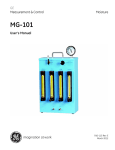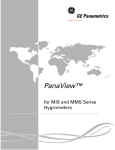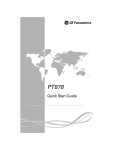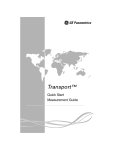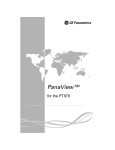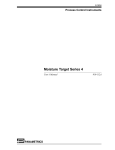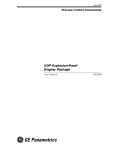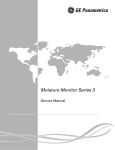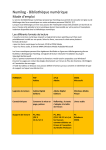Download GE Panametrics MG101 Portable Hygrometer Manual PDF
Transcript
Model MG101 Field Calibration System January 2004 Process Control Instruments Model MG101 Field Calibration System User’s Manual 910-115B January 2004 MG101 Field Calibration System iii January 2004 Warranty Each instrument manufactured by GE Panametrics is warranted to be free from defects in material and workmanship. Liability under this warranty is limited to restoring the instrument to normal operation or replacing the instrument, at the sole discretion of GE Panametrics. Fuses and batteries are specifically excluded from any liability. This warranty is effective from the date of delivery to the original purchaser. If GE Panametrics determines that the equipment was defective, the warranty period is: • one year for general electronic failures of the instrument • one year for mechanical failures of the sensor If GE Panametrics determines that the equipment was damaged by misuse, improper installation, the use of unauthorized replacement parts, or operating conditions outside the guidelines specified by GE Panametrics, the repairs are not covered under this warranty. The warranties set forth herein are exclusive and are in lieu of all other warranties whether statutory, express or implied (including warranties or merchantability and fitness for a particular purpose, and warranties arising from course of dealing or usage or trade). Return Policy If a GE Panametrics instrument malfunctions within the warranty period, the following procedure must be completed: 1. Notify GE Panametrics, giving full details of the problem, and provide the model number and serial number of the instrument. If the nature of the problem indicates the need for factory service, GE Panametrics will issue a RETURN AUTHORIZATION NUMBER (RAN), and shipping instructions for the return of the instrument to a service center will be provided. 2. If GE Panametrics instructs you to send your instrument to a service center, it must be shipped prepaid to the authorized repair station indicated in the shipping instructions. 3. Upon receipt, GE Panametrics will evaluate the instrument to determine the cause of the malfunction. Then, one of the following courses of action will then be taken: iv • If the damage is covered under the terms of the warranty, the instrument will be repaired at no cost to the owner and returned. • If GE Panametrics determines that the damage is not covered under the terms of the warranty, or if the warranty has expired, an estimate for the cost of the repairs at standard rates will be provided. Upon receipt of the owner’s approval to proceed, the instrument will be repaired and returned. January 2004 Table of Contents Introduction . . . . . . . . . . . . . . . . . . . . . . . . . . . . . . . . . . . . . . . . . . . . . . . . . . . . . . . . . . . . . . . . . . . 1 Theory Of Operation . . . . . . . . . . . . . . . . . . . . . . . . . . . . . . . . . . . . . . . . . . . . . . . . . . . . . . . . . . . . 1 Initial Considerations. . . . . . . . . . . . . . . . . . . . . . . . . . . . . . . . . . . . . . . . . . . . . . . . . . . . . . . . . . . . 3 Operating Range . . . . . . . . . . . . . . . . . . . . . . . . . . . . . . . . . . . . . . . . . . . . . . . . . . . . . . . . . . . . 3 Operating Environment. . . . . . . . . . . . . . . . . . . . . . . . . . . . . . . . . . . . . . . . . . . . . . . . . . . . . . . 3 Operating Requirements . . . . . . . . . . . . . . . . . . . . . . . . . . . . . . . . . . . . . . . . . . . . . . . . . . . . . . 4 Preliminary Setup . . . . . . . . . . . . . . . . . . . . . . . . . . . . . . . . . . . . . . . . . . . . . . . . . . . . . . . . . . . . . . 5 Operating Procedure . . . . . . . . . . . . . . . . . . . . . . . . . . . . . . . . . . . . . . . . . . . . . . . . . . . . . . . . . . . . 7 Calibrating the Moisture Samples. . . . . . . . . . . . . . . . . . . . . . . . . . . . . . . . . . . . . . . . . . . . . . . 8 Using Data Table 3 . . . . . . . . . . . . . . . . . . . . . . . . . . . . . . . . . . . . . . . . . . . . . . . . . . . . . . . . . . 9 Using Data Table 2 . . . . . . . . . . . . . . . . . . . . . . . . . . . . . . . . . . . . . . . . . . . . . . . . . . . . . . . . . 10 System Shutdown . . . . . . . . . . . . . . . . . . . . . . . . . . . . . . . . . . . . . . . . . . . . . . . . . . . . . . . . . . 11 Preparation for Shipping . . . . . . . . . . . . . . . . . . . . . . . . . . . . . . . . . . . . . . . . . . . . . . . . . . . . . . . . 12 Specifications. . . . . . . . . . . . . . . . . . . . . . . . . . . . . . . . . . . . . . . . . . . . . . . . . . . . . . . . . . . . . . . . . 13 Performance Specifications. . . . . . . . . . . . . . . . . . . . . . . . . . . . . . . . . . . . . . . . . . . . . . . . . . . 13 Operating Specifications . . . . . . . . . . . . . . . . . . . . . . . . . . . . . . . . . . . . . . . . . . . . . . . . . . . . . 13 Physical Specifications . . . . . . . . . . . . . . . . . . . . . . . . . . . . . . . . . . . . . . . . . . . . . . . . . . . . . . 13 Spare Parts List . . . . . . . . . . . . . . . . . . . . . . . . . . . . . . . . . . . . . . . . . . . . . . . . . . . . . . . . . . . . . . . 13 Formulas . . . . . . . . . . . . . . . . . . . . . . . . . . . . . . . . . . . . . . . . . . . . . . . . . . . . . . . . . . . . . . . . . . . . 15 Typical Examples . . . . . . . . . . . . . . . . . . . . . . . . . . . . . . . . . . . . . . . . . . . . . . . . . . . . . . . . . . . . . 16 Example 1 . . . . . . . . . . . . . . . . . . . . . . . . . . . . . . . . . . . . . . . . . . . . . . . . . . . . . . . . . . . . . . . . 16 Example 2 . . . . . . . . . . . . . . . . . . . . . . . . . . . . . . . . . . . . . . . . . . . . . . . . . . . . . . . . . . . . . . . . 16 Vapor Pressure and Calibration Tables . . . . . . . . . . . . . . . . . . . . . . . . . . . . . . . . . . . . . . . . . . . . . 16 v January 2004 Introduction The MG101 Field Calibration System is a portable moisture generator used for checking and if necessary, re-calibrating GE Panametrics moisture probes. The MG101 can generate dew/frost points in the range of -75 to +20°C (-103 to 68°F) dew/frost point temperature. It is a totally mechanical device requiring only a supply of dry nitrogen and is inherently explosion-proof. Although specifically designed for calibrating GE Panametrics moisture probes, the MG101 can be used for any application requiring accurate and repeatable moisture samples. Theory Of Operation Precise moisture concentrations are generated by passing dry nitrogen through a water saturator and mixing the resulting saturated stream with a dry nitrogen stream from the same source, for a first dilution. This resulting first dilution is then further diluted in a second mixing stage, resulting in dew/frost point temperatures as low as -75°C (-103°F). The MG101 Moisture Calibrator consists of a pressure regulator, four adjustable rotameters (flowmeters with valves), a saturator bottle, a filter, a temperature gauge, and a vent valve. The diagram and explanation on the following page describe how the MG101 works. 1 January 2004 Theory of Operation (cont.) As shown in Figure 1 below, dry nitrogen enters at the dry gas inlet A, passes through the fixed internal pressure regulator, and splits into the following three streams: • B - dry gas “first dilution” • C - wet gas • D - dry gas “second dilution” Stream B (the dry gas “first dilution”) is mixed with stream C (the wet gas) after it passes through the saturator bottles to form a “Wet gas diluted” mixture (stream E). This is then mixed with stream D (the “dry gas second dilution”) to generate the desired output mixture (stream F). Obtaining an accurate output mixture requires careful adjustment of the rotameter valves as described in Chapter 2, Operation. Note: The rotameter scales are used in later steps to reference a lookup table. By themselves they do not indicate units of flow. Calibration of all rotameters and the thermometer is traceable to NIST standards. Vent Valve Gas Outlet E Dry Down Valve Dry Gas First Dilution Flowmeter F Temp 5µ Filter Wet Gas Diluted Flowmeter Wet Gas Flowmeter B Dry Gas Inlet A Pressure Regulator C Saturator Bottle D Figure 1: Flow Schematic 2 Dry Gas Second Dilution Flowmeter January 2004 Initial Considerations Operating Range While the driest dew/frost point temperature capability specified for the MG101 is -75°C (-103°F), the actual limit is determined by the moisture content of the dry nitrogen source and by the ambient temperature. The driest dew/frost point temperature the MG101 can produce is the dew/frost point temperature of the dry nitrogen source plus 25°C (45°F). If dry nitrogen of this quality is not available, please contact GE Panametrics for assistance. The wettest dew/frost point temperature that can be generated is determined by the ambient temperature and must be at least 10°C (18°F) below the ambient temperature. Operating Environment The MG101 is designed to be used indoors or in an environment where ambient temperature changes are not extreme and where the device will not be subject to dramatic heating or cooling. It is important to ascertain that the temperature of the calibrator and in particular the saturator bottle will not change between the beginning and the end of the calibration cycle. Caution! Changes in saturator bottle temperature after calibration parameters have been established will cause errors in generated dew/frost point temperature. The MG101 can be damaged by freezing. Do not operate it in freezing temperatures. 3 January 2004 Operating Requirements You will need the following additional equipment to set up and operate the MG101 calibrator: • Nitrogen, preferably from a liquid source. Cylinders may be used; however, the supply gas must be 25°C (45°F) drier than the driest dew/frost point temperature to be generated. If cylinders must be used, two cylinders in parallel, plumbed to the inlet of the MG10, will increase the stability of the gas supply. • A stainless steel pressure regulator to set the inlet pressure to 55 psig. • 1/4” OD stainless steel tubing. • An appropriate test chamber (GE Panametrics Sample Cell # 2830 preferred for M2 Type probes). • A hygrometer to monitor the moisture sensor for either: • the dew/frost point reading, if simply verifying the moisture sensor performance, or • the sensor output signal, if generating a new calibration curve. Note: The hygrometer can be a dedicated instrument for use only with the moisture generator or the process instrument which will be used with the recalibrated sensor after the calibration is completed. 4 January 2004 Preliminary Setup Caution! Be sure you read and understand Initial Considerations on page 3 before proceeding. 1. Take off the back panel by removing the two small back screws (see Figure 2 below). 2. Fill the supplied plastic squeeze bottle with distilled (not deionized) water and connect it to the fill tubing at the bottom of the saturator bottle (see Figure 2 below). This length of plastic tubing is left permanently attached to the fitting at the bottom of the saturator bottle. Saturator Bottle Fill Mark Fill Tubing Petcock Screw 2 places Figure 2: MG101 Rear View (with panel removed) 3. Open the petcock. 4. Fully open the vent valve on the front panel by turning it counterclockwise, and turn the WET/DRY SELECTOR VALVE to WET (see Figure 3 on page 6). 5. Using the squeeze bottle, fill the saturator bottle until the water level reaches the fill mark on the bottle (see Figure 2 above). 6. Then, close the petcock and replace the back panel. 5 January 2004 Preliminary Setup (cont.) Wet/Dry Selection Valve Vent Valve Inlet Fitting Outlet Fitting Figure 3: MG101 Front View 7. Connect the nitrogen supply to the inlet fitting via the stainless steel pressure regulator using 1/4” OD stainless steel tubing (Swagelok® fittings are preferred throughout). 8. Connect the calibration chamber to the outlet fitting, using 1/4” OD SS tubing, and leak test the connection. The preferred calibration chamber for use with Type M2 moisture probes is GE Panametrics Sample Cell, part number 2830. At the outlet of the calibration chamber, connect at least 5 ft (1.5 m) of 1/4” OD tubing as a vent to the atmosphere. The tubing may be coiled to save space. 9. Insert the sensor to be calibrated into the calibration chamber and tighten it sufficiently to ensure a leak-proof seal (do not overtighten). N2 Supply Tank Pressure Regulator Calibration Chamber MG101 Figure 4: A Typical MG101 Test Setup 6 January 2004 Operating Procedure Refer to Figure 5 below and Figure 6 on page 9 to complete the following steps: 1. Fully close all four rotameter valves by turning them clockwise. 2. Set the WET/DRY selector valve to DRY. Caution! This valve must always be in the WET position before the “WET GAS” flowmeter valve is opened, and it must remain in this position until the “WET GAS” flowmeter valve is closed. 3. Set the pressure regulator on the inlet gas (nitrogen) line to approximately 55 psig. 4. Make sure the vent valve at the top of the front panel is fully open. 5. Fully open the valve on the WET GAS DILUTED rotameter. Note: The rotameters are dual range floating ball types, each having both a steel ball and a glass ball. When reading the rotameters be careful to watch either the steel ball or the glass ball (see Figure 5 below) as directed (numbers in tables are followed by an S or G to designate the ball material). Glass Ball (black) Steel Ball (silver) Valve Figure 5: Rotameter Valve and Balls 6. Open and adjust the valves on both the DRY GAS FIRST DILUTION and the DRY GAS SECOND DILUTION rotameters. Adjust each so that the steel ball indicates approximately “10” on the rotameter scale. 7. Next, adjust the vent valve so that the steel ball on the WET GAS DILUTED rotameter also reads approximately “10.” 7 January 2004 Operating Procedure (cont.) IMPORTANT: Leak test all connections from the N2 supply to the calibration chamber before proceeding. 8. Allow the nitrogen to purge through the entire system at the rotameter settings defined on the previous page. The calibration system will begin to dry down and eventually come to equilibrium with the dry nitrogen supply gas. The time required to achieve equilibrium will vary depending on the moisture level of the nitrogen (approximately 6 to 18 hours will be required). 9. Once the calibration system has reached equilibrium, set the valve on the WET/DRY rotometer to the WET position. Calibrating the Moisture Samples To generate calibrated moisture samples, proceed as follows: Note: Be sure to start with the driest calibration value and proceed to the wetter values since you cannot readily go from a wetter to a drier value. (Wetter to drier changes always require a longer equilibration period). For example, if you are calibrating a moisture probe over the range of -60°C dew/ frost point temperature to +10°C dew/frost point temperature, start with the -60°C dew/frost point temperature. 1. Check the saturator bottle temperature on the temperature gauge. 2. For each moisture calibration point you wish to generate, look at Data Tables 2 and 3 (supplied with the MG101). Note that above the line which reads “Generated Dew Points (Deg C),” is a row of values headed “Ambient Temperature (Deg C).” Find the column corresponding as closely as possible to the temperature measured in Step 1 above and read down the column of dew/frost points (dew points) in the table below this temperature. Note: The moisture value you wish to generate may be in either Data Table 2 or Data Table 3. You will find that “drier” calibration points are in Data Table 3 while “wetter” values are found in Data Table 2. The purpose of determining which table holds the desired calibration value is to direct you to the correct operating procedure. From this point on, the MG101 operating procedure depends on which table contains your calibration point. 8 • If your calibration point is in Data Table 3, go to page 9. • If your calibration point is in Data Table 2, go to page 10. January 2004 Using Data Table 3 Vent Valve Temperature Gage Wet/Dry Selector Valve Wet Gas Wet Gas Diluted Dry Gas First Dilution Dry Gas Second Dilution Rotameters Figure 6: Rotameters and Valves For calibration points found in Data Table 3, proceed as follows: 1. Fully open the vent valve by turning it counter-clockwise. Caution! Make the following adjustments slowly, being careful not to overshoot the target value. (DO NOT ALLOW THE SYSTEM TO GO TO A VALUE WETTER THAN THE TARGET VALUE). If you overshoot a value in the wetter direction, you will have to allow the system to equilibrate (dry down) again before you can proceed. 2. In Data Table 3, look below the body of the table for Notes 1 and 2. Adjust both the valves on the DRY GAS FIRST DILUTION and the DRY GAS SECOND DILUTION rotameters to the values shown. IMPORTANT: Be sure to read the steel or glass ball (S or G) as indicated. 3. Consult Data Table 3 for the desired dew/frost point temperature and find the corresponding value in the column headed WET GAS. Adjust the WET GAS valve to obtain the value indicated in Data Table 3. 9 January 2004 Using Data Table 3 (cont.) 4. By referring to the desired dew/frost point temperature in Data Table 3, find the corresponding value in the column headed WET GAS DILUTED. Adjust the vent valve (but not the valve on the WET GAS DILUTED rotameter, which remains fully open) to obtain the value indicated in Data Table 3. After stabilizing, the system output will be at the selected dew/frost point temperature and it will be ready for use. The stabilization period depends on the dew/frost point temperature you are using. In general, for dew/frost point temperatures of -60°C (-76°F) and drier, allow 2 hours. For dew/frost point temperatures between -60°C (-76°F) and -40°C (-40°F), allow 1 hour. For wetter dew/frost points, allow 30 minutes. When you have completed the calibration or other calibrated moisture operation at this dew/frost point temperature, either shut down the system (see page 11), or repeat the steps in this section for the next calibration point. Using Data Table 2 For calibration points found in Data Table 3, proceed as follows: 1. Fully close the vent valve by turning it clockwise. Caution! Make the following adjustments slowly, being careful not to overshoot the target value. (DO NOT ALLOW THE SYSTEM TO GO TO A VALUE WETTER THAN THE TARGET VALUE). If you overshoot a value in the wetter direction, you will have to allow the system to equilibrate or dry down again before you can accurately return to a drier value. 2. Fully close the DRY GAS FIRST DILUTION VALVE by turning it clockwise. 3. Consult Data Table 2 for the desired dew/frost point temperature and find the corresponding value in the column headed DRY GAS SECOND (DILUTION). Adjust the valve on the DRY GAS SECOND DILUTION rotameter to obtain the value shown. IMPORTANT: Be sure to read the steel or glass ball (S or G) as indicated. 10 January 2004 Using Data Table 2 (cont.) 4. By referring to the desired dew/frost point temperature in Data Table 2, find the corresponding value in either the column headed WET GAS or the column headed WET GAS DILUTED. Note that a given value appears in one column or the other but not both. Adjust the valve on the WET GAS rotameter (but not on the Wet Gas Diluted rotameter, which remains fully open) to obtain the reading indicated on either the WET GAS or the WET GAS DILUTED rotameter scales (whichever is indicated in the table). IMPORTANT: Be sure to read the steel or glass ball (S or G) as indicated. After equilibrium is established, the MG101 will be delivering a calibration gas with the selected dew/frost point temperature. When you have completed the calibration or other calibrated moisture operation at this dew/frost point temperature, either shut down the system (see below), or repeat the steps in this section for the next calibration point. System Shutdown If you are not planning another calibration run, you must shut the system down as follows: 1. Fully open the vent valve by turning it counter-clockwise. 2. Fully close the WET GAS VALVE by turning it clockwise. 3. Fully close the DRY GAS FIRST DILUTION VALVE by turning it clockwise. 4. Fully close the DRY GAS SECOND DILUTION VALVE by turning it clockwise. 5. Set the WET/DRY VALVE to DRY. 11 January 2004 Preparation for Shipping To ship or to move the MG101, refer to Figure 7 below and empty the saturator bottle as follows: 1. Remove the rear panel. 2. Fully open the vent valve by turning it counter-clockwise. 3. Place the end of the fill tubing in a container below the level of the saturator bottle and open the petcock. 4. When the saturator bottle is completely empty, close the petcock and the vent valve, and replace the rear panel. Saturator Bottle Fill Tubing Petcock Screw (2 places) Figure 7: Emptying the Saturator Bottle 12 January 2004 Specifications Performance Specifications Generated Dew/Frost Point Temperature Range: -75°C up to 10°C (18°F) below ambient temperature Accuracy: Operating Specifications ±1°C (±1.8°F) Inlet Gas Supply: Must be a minimum of 25°C (45°F) drier than the driest sample to be generated. Flow Rate: 0.2 liters/minute, maximum Inlet Pressure: 55-60 psig Outlet Pressure: Ambient to 10 psig, adjustable Power Requirements: None Physical Specifications Dimensions: 12W x 18H x 6D in. (304.8W x 457.2H x 152.4D mm) Inlet and Outlet Connections: 1/4” Swagelok® tube fitting Spare Parts List Part Number Qty Description MG-B125-20 1 20 mm flowmeter tube MG-B125-30 1 30 mm flowmeter tube MG-B125-50 2 50 mm flowmeter tube MG-V1 1 V1 standard valve MG-HR1 1 HR2 high resolution valve R16-201-N10A 1 Pressure Regulator 13 January 2004 18.00 (457) 12.00 (305) Notes: 1. Depth = 6.00 (152) 2. Dimensions are in inches (millimeters). 3. Inlet, Outlet and Vent Connections are 1/4” tube fittings. Figure 8: MG101 Moisture Generator Outline Dimensions 14 January 2004 Formulas The generated moisture content, as determined by the water vapor pressure, is calculated from: ⎛ P s F w1 + P d1 F d1⎞ F w ⎜ ---------------------------------------⎟ + P d × F d F w1 + F d1 ⎠ ⎝ P w = ----------------------------------------------------------------------------Fw + Fd (1) where: Pw = the generated vapor pressure of water Ps = the saturation vapor pressure of water as determined by the water temperature of the saturator. Pd = the vapor pressure of water in the dry nitrogen stream Fw = the flow rate of the wet gas diluted stream Fw1 = the flow rate of the wet gas stream Fd = the flow rate of the dry gas second dilution stream. Fd1 = the flow rate of the dry gas first dilution stream. In general PdFd << PsFw and Pd1Fd1 << PsFw1; therefore Equation C-1 above simplifies to: F w ⎞ ⎛ F w1 ⎞ ⎛ P w = ⎜ -------------------⎟ ⎜ -------------------------⎟ P s ⎝ F w + F d⎠ ⎝ F w1 + F d1⎠ (2) The value of Ps and the dew point (from the calculated value pw) are determined from a chart of vapor pressure of water as a function of temperature (see Table 1 on page 17). Equation 1 above produces an error of less than 2°C (3.6°F) dew/frost point temperature at the lowest generated dew/frost point temperatures, and virtually no error at higher generate dew/frost point temperatures. The advantage of Equation 2 above is that a precise determination of the dew/frost point temperature of the gas supply is not necessary. It is good practice, however, to use the hygrometer to determine an approximate dew/frost point temperature of the dry gas supply. To obtain the lowest dew/frost point temperatures within the specified accuracy, the dry gas supply should not exceed 3% of the desired mixture concentration. 15 January 2004 Typical Examples The following examples show typical calculations based on the equations presented on page 15. Example 1 Data Table 2 is provided with the MG101 to enable you to use the field calibration system to check sensor probe calibration without calculating the value of pw. Data Table 2 was compiled by calculating pw and thus, the dew/frost point temperature by Equation 2 on page 15. To use Data Table 2, set the rotameters per the columns headed “Dry Gas Setting” and either “High” or “Low Wet Gas Setting.” Moving horizontally across the chart, read the generated dew/frost point temperature under the appropriate temperature reading. Note: The term “Flowmeter” is used in the data tables and is equivalent to the word “rotameter” used in this manual. Example 2 To determine generated dew/frost point temperatures other than those listed in Data Table 2, Equation 2 on page 15 must be used as shown in the following example: If, Dry Gas first dilution flowmeter setting Fd1 = 4,500 cc/min Dry Gas second dilution flowmeter setting Fd = 4,500 cc/min Wet Gas flowmeter setting = 20 cc/min Fw1 = 140 cc/min Wet Gas diluted flowmeter setting Fw = 347 cc/min Thermometer reading T = 20°C and, Ps = 17.535 mm Hg at 20°C (from Table D-1 on page D-1) Then, P w F w ⎞ ⎛ F w1 ⎞ ⎛ P w = ⎜ -------------------⎟ ⎜ -------------------------⎟ P s ⎝ F w + F d⎠ ⎝ F w1 + F d1⎠ 140 cc ⁄ m in 347 cc ⁄ min = ⎛ --------------------------------------------------------------------⎞ ⎛ -------------------------------------------------------------------- ⎞ ⋅ ( 17.353m mHg ) ⎝ 347 cc ⁄ min + 4500 cc ⁄ min⎠ ⎝ 140 cc ⁄ m in + 4500 cc ⁄ m in⎠ And, Pw = 0.0375 mm Hg, which is equivalent to a dew/frost point temperature of 48°C (by interpolation). Vapor Pressure and Calibration Tables 16 Table 1 on page 17 is the vapor pressure of water as a function of temperature. Two tables not supplied here, Data Tables 2 and 3, are sets of calibrations generated at the factory for each MG101. These tables are supplied with the unit. You must use these tables to operate the MG101. Since each table is specific to your instrument, you cannot use a set from another unit. If you lose these tables, contact the factory and duplicates will be provided. January 2004 Table 1: Vapor Pressure of Water Note: If the dew/frost point is known, the table will yield the partial water vapor pressure (PW) in mm of Hg. If the ambient or actual gas temperature is known, the table will yield the saturated water vapor pressure (PS) in mm of Hg. Water Vapor Pressure Over Ice Temp. (°C) 0 2 4 6 8 -90 -80 -70 -60 0.000070 0.000400 0.001940 0.008080 0.000048 0.000290 0.001430 0.006140 0.000033 0.000200 0.001050 0.004640 0.000022 0.000140 0.000770 0.003490 0.000015 0.000100 0.000560 0.002610 -50 -40 -30 0.029550 0.096600 0.285900 0.023000 0.076800 0.231800 0.017800 0.060900 0.187300 0.013800 0.048100 0.150700 0.010600 0.037800 0.120900 Temp. (°C) 0.0 0.2 0.4 0.6 0.8 -29 -28 -27 -26 0.317 0.351 0.389 0.430 0.311 0.344 0.381 0.422 0.304 0.337 0.374 0.414 0.298 0.330 0.366 0.405 0.292 0.324 0.359 0.397 -25 -24 -23 -22 -21 0.476 0.526 0.580 0.640 0.705 0.467 0.515 0.569 0.627 0.691 0.457 0.505 0.558 0.615 0.678 0.448 0.495 0.547 0.603 0.665 0.439 0.486 0.536 0.592 0.652 -20 -19 -18 -17 -16 0.776 0.854 0.939 1.031 1.132 0.761 0.838 0.921 1.012 1.111 0.747 0.822 0.904 0.993 1.091 0.733 0.806 0.887 0.975 1.070 0.719 0.791 0.870 0.956 1.051 -15 -14 -13 -12 -11 1.241 1.361 1.490 1.632 1.785 1.219 1.336 1.464 1.602 1.753 1.196 1.312 1.437 1.574 1.722 1.175 1.288 1.411 1.546 1.691 1.153 1.264 1.386 1.518 1.661 -10 -9 -8 -7 -6 1.950 2.131 2.326 2.537 2.765 1.916 2.093 2.285 2.493 2.718 1.883 2.057 2.246 2.450 2.672 1.849 2.021 2.207 2.408 2.626 1.817 1.985 2.168 2.367 2.581 -5 -4 -3 -2 -1 3.013 3.280 3.568 3.880 4.217 2.962 3.225 3.509 3.816 4.147 2.912 3.171 3.451 3.753 4.079 2.862 3.117 3.393 3.691 4.012 2.813 3.065 3.336 3.630 3.946 0 4.579 4.504 4.431 4.359 4.287 17 January 2004 Table 1: Vapor Pressure of Water (Continued) Aqueous Vapor Pressure Over Water 18 Temp. (°C) 0.0 0.2 0.4 0.6 0.8 0 1 2 3 4 4.579 4.926 5.294 5.685 6.101 4.647 4.998 5.370 5.766 6.187 4.715 5.070 5.447 5.848 6.274 4.785 5.144 5.525 5.931 6.363 4.855 5.219 5.605 6.015 6.453 5 6 7 8 9 6.543 7.013 7.513 8.045 8.609 6.635 7.111 7.617 8.155 8.727 6.728 7.209 7.722 8.267 8.845 6.822 7.309 7.828 8.380 8.965 6.917 7.411 7.936 8.494 9.086 10 11 12 13 14 9.209 9.844 10.518 11.231 11.987 9.333 9.976 10.658 11.379 12.144 9.458 10.109 10.799 11.528 12.302 9.585 10.244 10.941 11.680 12.462 9.714 10.380 11.085 11.833 12.624 15 16 17 18 19 12.788 13.634 14.530 15.477 16.477 12.953 13.809 14.715 15.673 16.685 13.121 13.987 14.903 15.871 16.894 13.290 14.166 15.092 16.071 17.105 13.461 14.347 15.284 16.272 17.319 20 21 22 23 24 17.535 18.650 19.827 21.068 22.377 17.753 18.880 20.070 21.324 22.648 17.974 19.113 20.316 21.583 22.922 18.197 19.349 20.565 21.845 23.198 18.422 19.587 20.815 22.110 23.476 25 26 27 28 29 23.756 25.209 26.739 28.349 30.043 24.039 25.509 27.055 28.680 30.392 24.326 25.812 27.374 29.015 30.745 24.617 26.117 27.696 29.354 31.102 24.912 26.426 28.021 29.697 31.461 30 31 32 33 34 31.824 33.695 35.663 37.729 39.898 32.191 34.082 36.068 38.155 40.344 32.561 34.471 36.477 38.584 40.796 32.934 34.864 36.891 39.018 41.251 33.312 35.261 37.308 39.457 41.710 35 36 37 38 39 42.175 44.563 47.067 49.692 52.442 42.644 45.054 47.582 50.231 53.009 43.117 45.549 48.102 50.774 53.580 43.595 46.050 48.627 51.323 54.156 44.078 46.556 49.157 51.879 54.737 40 41 55.324 58.340 55.910 58.960 56.510 59.580 57.110 60.220 57.720 60.860 January 2004 Table 1: Vapor Pressure of Water (Continued) Aqueous Vapor Pressure Over Water (cont.) Temp. (°C) 0.0 0.2 0.4 0.6 0.8 42 43 44 61.500 64.800 68.260 62.140 65.480 68.970 62.800 66.160 69.690 63.460 66.860 70.410 64.120 67.560 71.140 45 46 47 48 49 71.880 75.650 79.600 83.710 88.020 72.620 76.430 80.410 84.560 88.900 73.360 77.210 81.230 85.420 89.790 74.120 78.000 82.050 86.280 90.690 74.880 78.800 82.870 87.140 91.590 50 51 52 53 54 92.51 97.20 102.09 107.20 112.51 93.50 98.20 103.10 108.20 113.60 94.40 99.10 104.10 109.30 114.70 95.30 100.10 105.10 110.40 115.80 96.30 101.10 106.20 111.40 116.90 55 56 57 58 59 118.04 123.80 129.82 136.08 142.60 119.10 125.00 131.00 137.30 143.90 120.30 126.20 132.30 138.50 145.20 121.50 127.40 133.50 139.90 146.60 122.60 128.60 134.70 141.20 148.00 60 61 62 63 64 149.38 156.43 163.77 171.38 179.31 150.70 157.80 165.20 172.90 180.90 152.10 159.30 166.80 174.50 182.50 153.50 160.80 168.30 176.10 184.20 155.00 162.30 169.80 177.70 185.80 65 66 67 68 69 187.54 196.09 204.96 214.17 223.73 189.20 197.80 206.80 216.00 225.70 190.90 199.50 208.60 218.00 227.70 192.60 201.30 210.50 219.90 229.70 194.30 203.10 212.30 221.80 231.70 70 71 72 73 74 233.70 243.90 254.60 265.70 277.20 235.70 246.00 256.80 268.00 279.40 237.70 248.20 259.00 270.20 281.80 239.70 250.30 261.20 272.60 284.20 241.80 252.40 263.40 274.80 286.60 75 76 77 78 79 289.10 301.40 314.10 327.30 341.00 291.50 303.80 316.60 330.00 343.80 294.00 306.40 319.20 332.80 346.60 296.40 308.90 322.00 335.60 349.40 298.80 311.40 324.60 338.20 352.20 80 81 82 83 355.10 369.70 384.90 400.60 358.00 372.60 388.00 403.80 361.00 375.60 391.20 407.00 363.80 378.80 394.40 410.20 366.80 381.80 397.40 413.60 19 January 2004 Table 1: Vapor Pressure of Water (Continued) Aqueous Vapor Pressure Over Water (cont.) 20 Temp. (°C) 0.0 0.2 0.4 0.6 0.8 84 416.80 420.20 423.60 426.80 430.20 85 86 87 88 89 433.60 450.90 468.70 487.10 506.10 437.00 454.40 472.40 491.00 510.00 440.40 458.00 476.00 494.70 513.90 444.00 461.60 479.80 498.50 517.80 447.50 465.20 483.40 502.20 521.80 90 91 92 93 94 525.76 546.05 566.99 588.60 610.90 529.77 550.18 571.26 593.00 615.44 533.80 554.35 575.55 597.43 620.01 537.86 558.53 579.87 601.89 624.61 541.95 562.75 584.22 606.38 629.24 95 96 97 98 99 633.90 657.62 682.07 707.27 733.24 638.59 662.45 687.04 712.40 738.53 643.30 667.31 692.05 717.56 743.85 648.05 672.20 697.10 722.75 749.20 652.82 677.12 702.17 727.98 754.58 100 101 760.00 787.57 765.45 793.18 770.93 798.82 776.44 804.50 782.00 810.21 WORLDWIDE OFFICES MAIN OFFICES: GE PANAMETRICS INTERNATIONAL OFFICES: USA GE Panametrics 221 Crescent St., Suite 1 Waltham, MA 02453-3497 USA Telephone: 781-899-2719 Toll-Free: 800-833-9438 Fax: 781-894-8582 E-mail: [email protected] Web: www.gepower.com/panametrics ISO 9001 Certified Australia P.O. Box 234 Gymea N.S.W. 2227 Australia Telephone 61 (02) 9525 4055 Fax 61 (02) 9526 2776 E-mail [email protected] Japan 2F, Sumitomo Bldg. 5-41-10, Koishikawa, Bunkyo-Ku Tokyo 112-0002 Japan Telephone 81 (03) 5802-8701 Fax 81 (03) 5802-8706 E-mail [email protected] Austria Waldgasse 39 A-1100 Wien Austria Telephone +43-1-602 25 34 Fax +43-1-602 25 34 11 E-mail [email protected] Korea Kwanghee Bldg., 201, 644-2 Ilwon-dong, Kangnam-Ku Seoul 135-945 Korea Telephone 82-2-445-9512 Fax 82-2-445-9540 E-mail [email protected] Benelux Postbus 111 3870 CC Hoevelaken The Netherlands Telephone +31 (0) 33 253 64 44 Fax +31 (0) 33 253 72 69 E-mail [email protected] Spain Diamante 42 28224 Pozuelo de Alarcon Madrid Spain Telephone 34 (91) 351.82.60 Fax 34 (91) 351.13.70 E-mail [email protected] France BP 106 11 Rue du Renard 92253 La Garenne Colombes Cedex France Telephone 33 (0) 1 47-82-42-81 Fax 33 (0) 1 47-86-74-90 E-mail [email protected] Sweden Box 160 S147 23 Tumba Sweden Telephone +46-(0)8-530 685 00 Fax +46-(0)8-530 357 57 E-mail [email protected] Germany Mess-und Pruftechnik Robert-Bosch-Straße 20a 65719 Hofheim Germany Telephone +49-6122-8090 Fax +49-6122-8147 E-mail [email protected] Taiwan 7th Fl 52, Sec 3 Nan-Kang Road Taipei, Taiwan ROC Telephone 02-2788-3656 Fax 02-2782-7369 E-mail [email protected] Italy Via Feltre, 19/A 20132 Milano Italy Telephone 02-2642131 Fax 02-26414454 E-mail [email protected] United Kingdom Unit 2, Villiers Court 40 Upper Mulgrave Road Cheam Surrey SM2 7AJ England Telephone 020-8643-5150 Fax 020-8643-4225 E-mail [email protected] Ireland GE Panametrics Shannon Industrial Estate Shannon, Co. Clare Ireland Telephone 353-61-470200 Fax 353-61-471359 E-mail [email protected] ISO 9002 Certified July 2003 USA GE Panametrics 221 Crescent Street, Suite 1 Waltham, MA 02453-3497 Telephone: (781) 899-2719 Toll-free: (800) 833-9438 Fax: (781) 894-8582 E-Mail: [email protected] Web: www.gepower.com/panametrics Ireland GE Panametrics Shannon Industrial Estate Shannon, County Clare Ireland Telephone: 353-61-470200 Fax: 353-61-471359 E-Mail: [email protected]



























